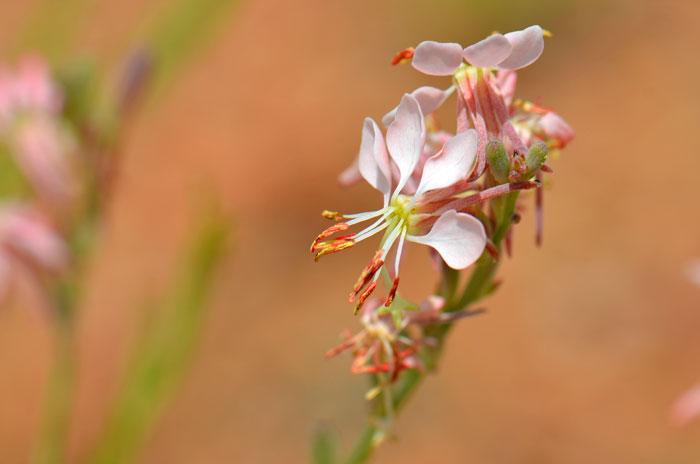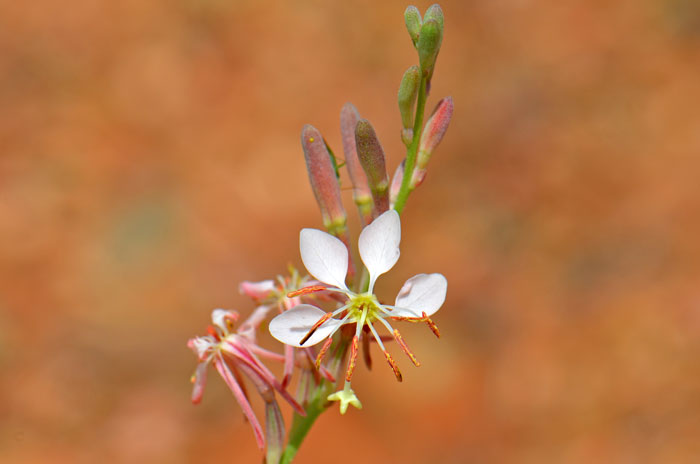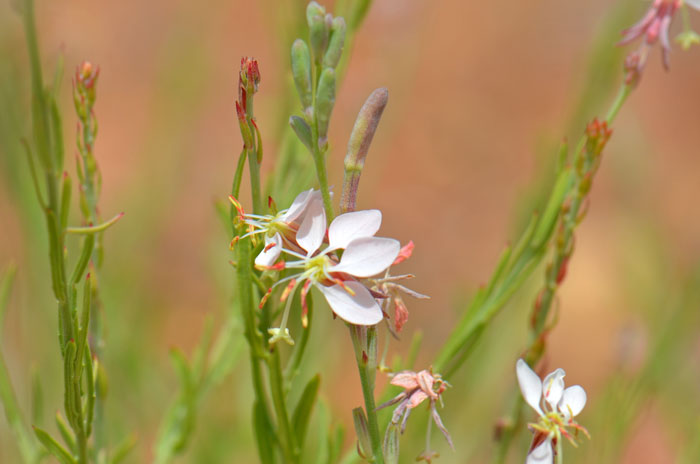Oenothera suffrutescens (Gaura coccinea), Scarlet Beeblossom



Scientific Name: Oenothera suffrutescens (Gaura coccinea)
Common Name: Scarlet Beeblossom
Also Called: Gaura, Scarlet Gaura, Scarlet Guara, (Spanish: Linda Tarde, Aretitos)
Family: Onagraceae, Evening Primrose Family
Synonyms: (Gaura coccinea, Gaura coccinea var. arizonica, Gaura coccinea var. epilobioides, Gaura coccinea var. glabra, Gaura coccinea var. parvifolia, Gaura coccinea var. typica, Gaura glabra, Gaura odorata)
Status: Native
Duration: Perennial;
Size: Up to 4 feet, usually smaller.
Growth Form: Forb/herb, subshrub; branched below ground.
Leaves: Green; linear to narrow-elliptic, margins entire to wavy.
Flower Color: White, fading to pink and scarlet; flowering stems in bracts; fruit erect or spreading.
Flowering Season: April to September.
Elevation: 2,000 to 8,000 feet.
Habitat Preferences: Dry flats and slopes, plains, prefers a limestone substrate; Joshua-tree and pinyon/juniper communities.
Recorded Range: Scarlet Beeblossom is found throughout most of North America and it is also native to northern and central Mexico and perhaps beyond. In Arizona it is found throughout most of the state with few records in La Paz and Yuma Counties.
North America & US County Distribution Map for Oenothera suffrutescens.
U.S. Weed Information: Oenothera suffrutescens is listed in Weeds of Nebraska and the Great Plains. Plants included here may become weedy or invasive.
Invasive/Noxious Weed Information: Oenothera suffrutescens is listed as a Noxious Weed by the State of California (Gaura coccinea, Scarlet Gaura, B list (noxious weeds). Plants included here are invasive or noxious.
Wetland Indicator: No information available.
Threatened/Endangered Information: No information available.
The Plant List includes 706 scientific plant names of species rank for the genus Oenothera. Of these 150 are accepted species names.
Comments: Scarlet Beeblossom has extensive rhizomes and forms large colonies. The flowers are fragrant. The Native Plant Information Network has an excellent summary of Scarlet Beeblossom.
Also see in Southwest Desert Flora: Tufted Evening Primrose, Oenothera caespitosa; California Suncup, Oenothera californica; Crownleaf Evening Primrose, Oenothera coronopifolia; Velvetweed, Oenothera curtiflora; Dune Evening Primrose, Oenothera deltoides; Hooker's Evening Primrose, Oenothera elata; Large Yellow Desert Primrose, Oenothera primiveris; Rose Evening Primrose, Oenothera rosea and Mexican Evening Primrose, Oenothera speciosa.
Scarlet Beeblossom has been used as an anti-emetic (Navajo, Ramah Drug), for panacea purposes (Navajo, Ramah Drug ) and as a pediatric aid (Navajo, Ramah Drug). See ethno-botanical uses at Native American Ethnobotany, University of Michigan, Dearborn.

